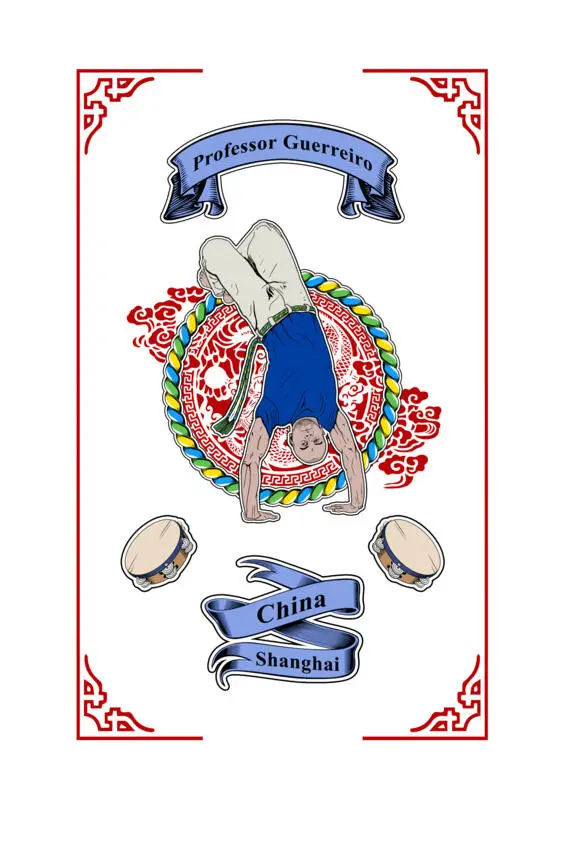• Tiago – Rabo de Arraia – Portugal
• Yuni – Capoeira Mandinga – Belgium
• I (Curiosa) – Cordão de Ouro – Russia
Moments like these are worth living for!
It all ended with sincere conversations about where everyone was from, which school they represented and how they ended up in China.
Training in the Capoeira Brasil Group.
Late, but I arrived for the class. The master conducts training with humor, but makes you sweat with a lot of repetitions. There was only one Chinese student among us. There was also another Russian girl and all the same faces: Taf and Matthew.
At that training session, I felt out of place as never before. This was not my capoeira. The very approach to training was completely different. Although I must admit that such training was necessary for me on a regular basis in order to learn to play quickly and strongly at a new level.
Conversation with Instrutor Virtual.
Let's go back to Shanghai and talk to Nico a bit.
Curiosa: What is the state of capoeira in China?
Nico: Officially, Capoeira Mandinga Shanghai was established in 2008, then it came to Beijing and then to Taiwan. Then a student from Russia who started with me moved to Hangzhou (a city one hour away from Shanghai). There were already some people who were doing capoeira there, but it was a very small group, which wasn’t really affiliated with anyone. After some time, they also wanted to join the group of capoeira Mandinga. There’s also one guy in Hefei who has 3 or 4 students already. One girl from Hangzhou also moved to a city close to the border with Thailand, she already has around ten students. So, there are three major cities and these two little groups. In Shanghai, there are two groups of capoeira Mandinga now. The person who moved to Hangzhou came back and started his own group. Now the two groups meet for a Saturday open rodas once a month.
The other teacher’s name is Alex, Chupateta. His group has about 5 to 15 people, whereas my group has 6 to 25 students depending on the day of the week. Students of the Capoeira Brasil group also come to the Saturday open rodas.
Curiosa: Many students left Shanghai and started groups in many other cities. Were all these students advanced enough to start teaching adults on their own?
Nico: When Diego came to Shanghai in 2005, he had only three years in capoeira, he didn’t find any capoeira group there and asked his master in Italy if he could start teaching capoeira. His master said that he could not and that his only option was to stop doing capoeira.
Diego didn’t listen to his master and started to teach. Then they invited Mestre Marcelo and became Capoeira Mandinga. So, when he started, he was just a yellow belt and then for many years he had the highest level in China. But then Capoeira Brasil came and people there had a higher level. I started to teach with dark green belt. Once in a while I would teach what I knew.
Then when you go to another city and there’s no capoeira, so what do you do? You’re like: hello, I have three years in capoeira, do you want to try? And it starts like that.»
Curiosa: What belts do your students have?
Nico: The highest level in my group is yellow belt. Half of the people in my group started with Diego and all the beginners started with me.
There is another guy in Shanghai that is even more advanced than me. He is from the USA and used to be part of Mandinga group but decided to leave. He is not affiliated with any group now. He teaches capoeira in a gym and supports all the rodas.
Professor Guerreiro 33 33 A warrior.
– Shanghai, China

***
I have already said that Diego returned to Italy. He now lives in Milan with his wife Elisa (Instrutora Princesa 34 34 A princess.
). I met her at a seminar in Milan in October 2019. There were several people with Capoeira Mandinga logos on their pants. I didn’t know anyone from their group in Italy at all, so I went up to say hello and told them of my desire to attend Diego’s classes. Elisa, as it turned out, knew about my existence. I told her about my project and that I wanted to meet Diego and interview him. On the same date, Diego himself was at a seminar in Shanghai with his group.
I must say that Diego’s move to Italy was in many ways a decisive factor in my decision to travel to Italy. I was eager to go there almost every year, but something always hindered this desire. I had heard so much about this country that it seemed that I had already visited there. Then I realized that without a visit to Diego, I would not be able to finish the chapter on capoeira in China. Moreover, other very talented capoeiristas live there, so I would able to talk to them as well.
At last, the long-awaited meeting with Diego took place. I remember it was a Tuesday evening, I walked for a very long time along the dark, cool streets of Milan, cursing at the endless cobblestones, where my small suitcase was constantly getting stuck. Not without difficulty, I found the entrance to the gym, I didn’t see any familiar faces. They let me into the locker room but then I did not understand where to go, and no one understood me. But when we did finally found each other, I was very surprised how pleasant and humble Diego was.
Diego turned out to be a very jovial, pleasant, open and down-to-Earth person. I would never have suspected that behind such a face there was such a force and such a story. When I understood what work he had done both in China and in Italy, what success he has achieved in capoeira, I wanted to give him a standing ovation and shout “bravo!”.
Conversation with Diego
At the first class on Tuesday, I sat in a corner and just watched the class – it seems that I had a fever back then as my head was splitting. Luckily, we managed to make an appointment to meet early before the next class on Thursday for an interview.
And so, it happened. We met in the lobby of the sports center before training. Diego was with his wife, Elisa, who added comments to some of his answers. Diego was so quick and clear in answering the questions, it was as if he had already been rehearsing the answers.
Sit back and enjoy this incredible dialogue.
Curiosa: Where are you from? When did you start capoeira? What did you do before capoeira?
Diego: I am from Italy, Naples to be specific. I started capoeira in 2001. Before that, I did judo for 4 years, taking part in competitions. Then I received a shoulder injury and I decided to start another sport. I was studying in university back then, so I was 19 or 20 years old. My friend suggested that I try capoeira, so we went together, and started to train with a teacher, his name is Tatu from the Balanço do Mar. It is the current name of the group in Napoli. I trained there for almost 3 years. Then I spent 6 months in Beijing in 2004, but I didn’t do any capoeira there. Then I came back to Italy, to Napoli. And in September 2005, I moved to Shanghai.
Curiosa: Why Shanghai? Why China?
Diego: I studied international relations along with Chinese language at university, so I went to China to study. And in 2005 I went to Shanghai because I won a scholarship from the Italian Minister of Foreign Affairs and they sent me to Shanghai. When I came, I looked for capoeira everywhere. I was going to Brazilian restaurants and then a Brazilian guy told me there was a guy in a park in Shanghai doing capoeira on weekends. So, I went there, I found the guy. He was there with a bunch of people. And actually, he was leaving and he asked me and another French guy to continue with the classes. So, basically it was just a group of people, they were training on Saturdays and on Sundays, once a week when there was no rain. And we continued to teach.
Читать дальше













